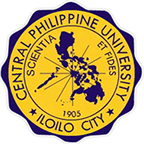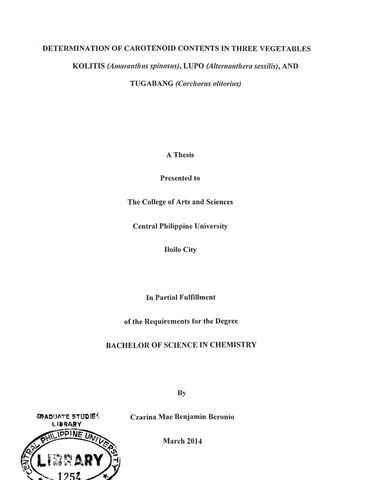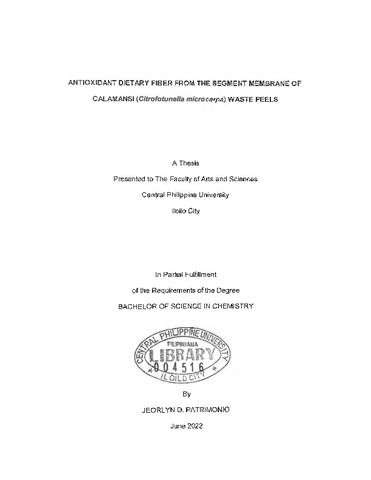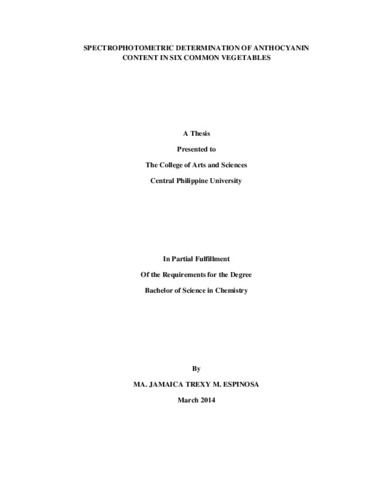Search
Now showing items 1-5 of 5
Determination of carotenoid contents in three vegetables Kolitis (Amaranthus spinosus), Lupo (Alternanthera sessilis), and Tugabang (Corchorus olitorius)
(2014)
This study aimed to determine the presence of carotenoids in three vegetable samples Kolitis (Amaranthus spinosus), Lupo (Alternanthera sessilis), and Tugabang (Corchorus olitorius). The carotenoids were extracted using absolute ethanol and determined using UV/Vis spectroscophotometer. The absorption of B-carotene, Astaxanthin, Lycopene and Zeaxanthin were read at wavelength of 450, 466, 471, and 478 nm respectively. From the results, it was found that kolitis had 23.3 pg/g of B-carotene, 76.7 pg/g Astaxanthin, 46.6 pg/g Lycopene, and 83.3 pg/g Zeaxanthin. Tugabang had 21.0 pg/g B-carotene, 76.1 pg/g Astaxanthin, 46.7 pg/g Lycopene, and 71.4 pg/g Zeaxanthin. Lupo had 23.1 pg/g B-carotene, 76.7 pg/g Astaxanthin. 48.1 pg/g Lycopene, and 72.2 pg/g Zeaxanthin. Many antioxidant products are being sold in the market. However, it is uncertain if all of them are effective and safe. Based on the result of this study, it is recommended to include kolitis, tugabang, and lupo in the diet to obtain carotenoids which is a source of vitamin A....
Antioxidant activity, total phenolic and flavonoid content of bioactive fractions of Symplocos polyandra leaves
(2022)
Symplocos polyandra, locally known as balakbakan, is distributed throughout Southeast Asia, especially in the Philippines. The lack of available literature regarding the phytochemistry of this plant species prompted the conduct of testing of its potential antioxidant activity and quantification of its total flavonoid content and phenolic content. Balakbakan leaves were collected, exhaustively extracted with methanol, and fractionated on a silica gel column. 2,2-diphenyl-1-picrylhydrazyI (DPPH) assay showed that the acetone fraction has the highest percent DPPH radical inhibition with 86.41% at 500 ppm compared to 0.5 mM ascorbic acid at 87.61%. The acetone - methanol fraction has the highest ferric reducing capacity with a value of 208.24 μM ascorbic acid equivalents at 500 ppm. The total phenolic content of the different fractions ranged from 21.88 to 29.99 pg/mL catechin equivalents, with hexane - acetone fractions having the highest value. The flavonoid content ranged from 14.28 to 16.64 pg/mL catechin equivalents, with the methanol fraction having the highest value. The compounds responsible for the high antioxidant activity may not be a phenolic or flavonoid. Fractions from Symplocos polyandra are a promising source of bioactive compounds with antioxidant activity. Cytotoxicity test and analyses of alkaloid and chlorophyll content of the leaves is recommended for the leaves to be developed into tea products....
Antioxidant activity and total phenolics and flavonoids contents of bioactive fractions of calamansi (Citrofortunella microcarpa) peels
(2022)
The purpose of this study is to investigate the antioxidant activity of fractions from epicarpium of Citrofortunella microcarpa (Philippine Lime) peels extract. Dried epicarpium of peels were extracted with methanol and fractionated with silica column and subjected to DPPH and FRAP assays as well as determination of total phenolic and flavonoid content. Three fractions were obtained after silica gel fractionation. The acetone-methanol fraction had the highest antioxidant activity with 81.06% DPPH radical inhibition and ferric reducing capacity of 1420.33 pM Fe<sup>2+</sup> released, in comparison with ascorbic acid standard of 88.26% DPPH inhibition and ferric reducing activity of 502.038 ascorbic acid equivalents, respectively. The acetone-methanol fraction also contained the highest total phenolic and flavonoid content at 73.26 and to 55.11 μg/mL catechin equivalents, respectively. This demonstrates that the high antioxidant activity of the acetone-methanol fraction can be attributed to its high total phenolic and flavonoid content. Value could be added to calamansi waste peels by developing the peels extracts into products such as high antioxidant functional foods, or antioxidant dermal cream or ointments....
Antioxidant dietary fiber from the segment membrane of calamansi (Citrofortunella microcarpa) waste peels
(2022-06)
Calamansi is a condiment used in a vast variety of Filipino dishes, as well as an ingredient in various beverages, such as calamansi juice. Calamansi peels are discarded as waste. Thus, this research study was conducted ...
Spectrophotometric determination of anthocyanin content in six common vegetables
(2014)
Anthocyanins, the natural colorants that belong to a group of plant compounds called flavonoids, are responsible for most of the red, orange, purple, violet, magenta, and blue colors found in fruits, vegetables, legumes, flowers, and other plants. The six vegetables specifically imparting the red-violet to purple color which are of interest to the researcher are camote (Ipomoea batatas), lupo (Alternanthera sessilis), kolitis (Amaranthus tricolor), kadios (Cajanus cajan), balagay (Psophocarpus tetragonolobus), and sitaw (Vigna sesquipedalis). The objectives of this study were to quantify the total anthocyanin content (TAC) from each particular vegetable’s part which are the leaves, seedpods, and the seeds; and relate them to their anti-oxidant and disease-fighting potentials to benefit humankind. Total anthocyanin content in the methanol extracts were analyzed using the pH differential method. Spectrophotometric quantitation was used at 520 nm and the concentration was expressed as ug/g cyanidin-3-glucoside. Results showed that 4 out of these 6 vegetables have positive values for TAC. Balagay has the least TAC (5.68 ± 0.6), followed by camote tops (6.57 ± 0.3), sitaw (18.2 ± 0.1), and finally kadios having the highest value (50.6 ± 1.1). On the other hand, 2 vegetables were found to have negative values for TAC, lupo (-6.98 ± 0.1) and kolitis (-1.25 ± 0.1), which are suspected to have another type of plant pigment, specifically a betalain. It is recommended that qualitative tests be performed on both plants, to confirm the presence of betalains, and quantify them if proven present; determine the antioxidant properties of each; and identify what specific compound causes this property. It is further recommended to include at least one of the four vegetables in the diet due to its many health benefits, at affordable prices....






